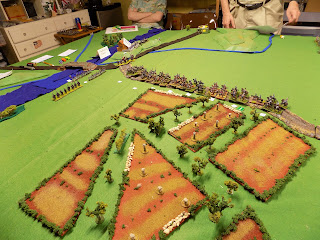Our imbalanced scenario today sees a reinforced French rear-guard corps attempting to escape encirclement by the allied armies. The game is loosely based on the events at Leipzig in 1813 and the subsequent retreat. As such, II Corps and attachments must cross two rivers and pass over the 11.5' table. The French and Swiss under Marshal Oudinot will be opposed by Prussians, Austrians, Swedes and Russians. The scenario, originally published in Wargames Digest allows each side to field a corps from 1809-1813. Some house rules were in effect but essentially it was Empire (V) at it's best.
This is a long report with lots of pictures. Click on the images to enlarge them Comments welcomed.
After the first "Grand Tactical" move, the French have all their cavalry leading, looking towards the distant bridge.Which is guarded by a Young Guard brigade, Old Guard heavy battery, and two excellent cavalry regiments. A walled Benedictine monestary sits on one flank. Both rivers cannot be forded, though the main body has a pontoon train with two bridges loaded.
Utilizing the road bonus, the French cavalry races for sanctuary past the autumn fields and the far bank. But the Coalition forces have not been idle.
The Swedish contingent emerges through the orchard on the French right as a pontoon bridge goes up, and a Prussian brigade appears on their left. Maybe that cavalry will be needed?
A small Russian corps (aren't they all?) arrives in the middle of the table, ready to fight. With everyone. The Russian commander had to be repeatedly reminded that the Prussians were on his side. Today.
A Prussian infantry brigade/division rumbles into action, unable to fully clear the bridge initially.
The Swiss "Red" division moves to engage the Swedes while a French division fans out and the Swedes take the middle ground opposing them all. The French cavalry is recalled.
But the Russians cut them off and engage them all along their line, even siezing a walled farm complex that was unattended.
In the following hour the Austians belatedly arrive to attempt to cut off the retreat. The French Guard elements take up position to contest the attack.
Charge after charge are resolved in the center with honors even. Though some of the results are decidedly unexpected. The French cavalry will not be riding to the rescue though.
The Prussian brigade finally clears the bridge and starts to advance. The French, perhaps not appreciating the gravity of the situation adopt a defensive posture rather than trying to brush aside the Prussian line and Landwehr.
The Austrians prepare an enormous wave assault in column against the Guards holding the area around the monestory.
The French, satisfied with their formations, beginning to push out from the bridgehead, though Swedish lines and Prussian columns with artillery support await. Time is not on the side of the French.
The Swedish and Russian cavalry begin to converge on the crossroads and make it even more unlikely that the cavalry will link up with the main body again.
A third Prussian brigade comes on table, rich with cavalry and a grenadier brigade. The jaws of the trap are fully beginning to close. Back at the orchard, the Swiss are mangling the Swedish infantry, but it won't matter if the road is closed.
Looking at a bigger picture, the French are jammed up at the original bridge and cannot even deploy their superior infantry against the blockaders.
Incredibly, with a small percentile chance, the Austrian waves roll over the defenders and evict the French Guard from the monestary. The bridge across the Medlinburg River starts to get congested and the French cavalry is starting to find the far bank appealing.
The French infantry has hardly advanced, which is not really surprising. With the huge number of cavalry charges to resolve we didn't get in many hourly rounds of play in the many hours we were together.
































